9.3 An Advanced Look into What is Staking Crypto
Free Airdrop Season 7 is LIVE! Answer fun questions or do simple tasks to earn rewards from the $30K BitDegree prize pool. Participate Now ! 🔥
In this section, we’re going to talk about what is staking crypto, how does one participate in it, and is staking crypto safe and worth it, to begin with.
The connection between crypto and staking is like the connection between kickflips and skating. They just go together, and, if you really want to understand DeFi, you can’t avoid tackling this concept, as well. Since you’re reading this section, you’re on the right path!
Crypto staking is a source of much confusion. Questions like “is staking crypto worth it?”, or “is staking crypto safe?” are all over online crypto forums. It’s a puzzling mechanism, and it’s a good sign that people are willing to learn and understand it better. And so, today, this confusion ends, because I’m here to explain things!
In this section, we’re going to answer the questions of what is staking crypto, is it safe, what’s the main risk of staking crypto, and many other staking-related questions in more depth (though, you can find a more basic approach here). By the end of your reading, you’ll have all of the knowledge to form an opinion of your own, whether staking is an attractive concept to you or not!!
Let’s do this!

Video Explainer
Video Explainer: An Advanced Look into What is Staking Crypto
Reading is not your thing? Watch the "An Advanced Look into What is Staking Crypto" video explainer
What is Staking Crypto? (Rewards & Risks Explained SIMPLY)


What is Staking Crypto?
When explaining what is staking crypto, many articles, videos, and tutorials tend to compare it to depositing money in interest-accumulating accounts in traditional banks. Even though there are some similarities between these two practices, it would be a mistake to think that crypto staking is a DeFi equivalent of depositing money in a regular bank savings account. You’ll soon see why.
Let’s begin by defining what is staking crypto.
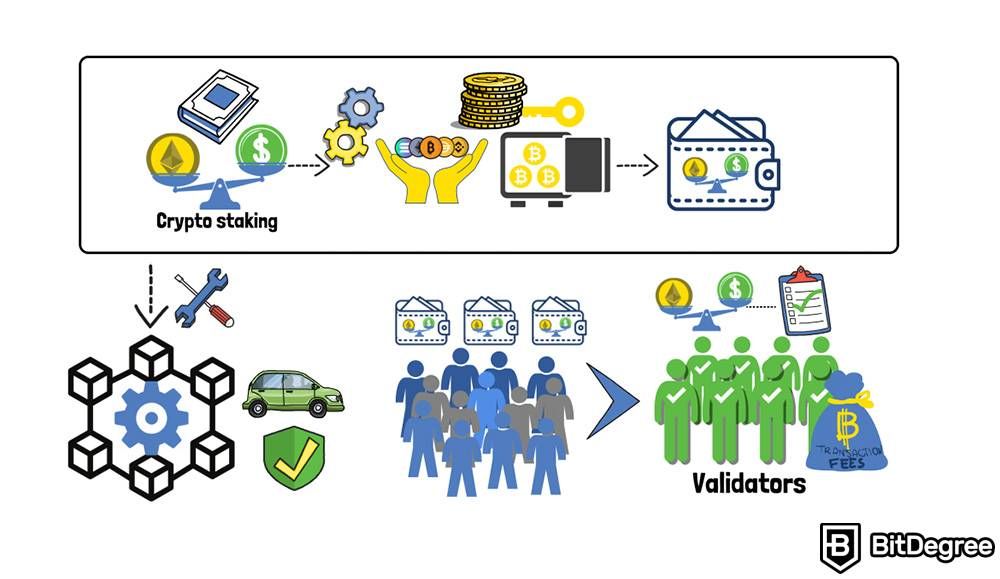
Staking in crypto refers to the process of either holding or locking up a certain amount of crypto assets in a specially-designated crypto wallet. It’s done in order to support the operations of a blockchain network, to make it run smoothly and securely.
In many cases, those who choose to stake their assets are known as validators. By staking, they get assigned a responsibility, and, if they carry it out correctly, they get rewarded by receiving transaction fees. So, what is this responsibility?
Validators, well… Validate the authenticity and accuracy of the transaction records, making sure only the correct data is being encrypted into the blockchain. Thus, as validators validate transactions, they are responsible for the creation of new blocks, as well. So, overall, validators are busy with maintaining the network's integrity, security and functionality.
Here’s a down-to-earth example. Imagine you’re a second-hand bookshop owner. Your job consists of finding pre-read books, and reselling them. So, whenever a new package of books arrives, you add them to your lists, and then sort in bookshelves.
You can see these books as transactions, and the owner as the validator, who not only logs in and validates them in a ledger, but also arranges them in an order, thus continuously forming the blockchain.
But, the whole process does not simply rely on the good faith of the validators. Any attempt at behaving maliciously, for example, trying to validate wrong transaction data, or tampering with the existing blockchain transaction history, could result in validators losing their staked assets.
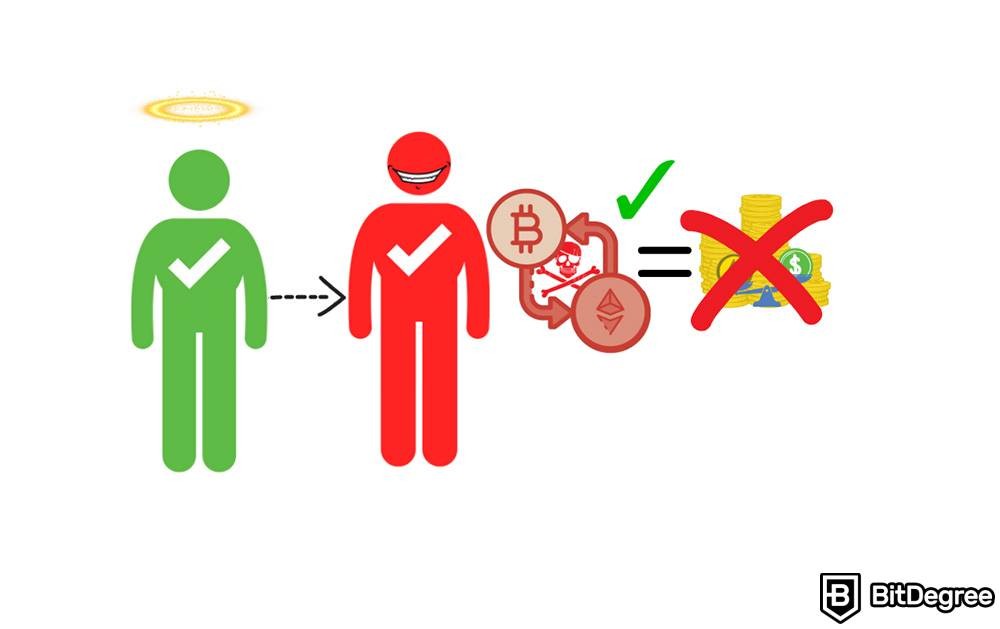
Yet, if they do their job the right way, they get paid. The amount of profit that validators receive from staking differs, as it depends on such factors as the staked amount, duration of staking, and the network's inflation rate. And it varies from blockchain to blockchain, too!
But, essentially, staking entails a responsibility that’s vital to the existence of many blockchains, such as the Ethereum network. To them, it serves as an alternative to mining processes that ensure the safety and functionality of other blockchain networks, such as the Bitcoin network.
As you see, staking isn’t simply locking your funds away, in order to receive interest rates later on, as it would be with traditional banking and savings accounts. Staking is the backbone of many important blockchains!
But, in order to get a grasp of crypto staking, we have to look at the bigger picture. And it’s all about understanding what is “Proof-of-Stake,” a consensus mechanism that creates the need for staking.
Proof-of-Stake
Blockchains that run on Proof-of-Stake are directly dependent on staking. But let’s take a deeper look at these overly-technical terms.
A consensus mechanism is like a set of rules that lay out how a blockchain operates. Consensus mechanisms vary from blockchain to blockchain, yet they all have the same purpose - to ensure that all network participants reach an agreement on how the blockchain is supposed to be running without relying on a central authority.
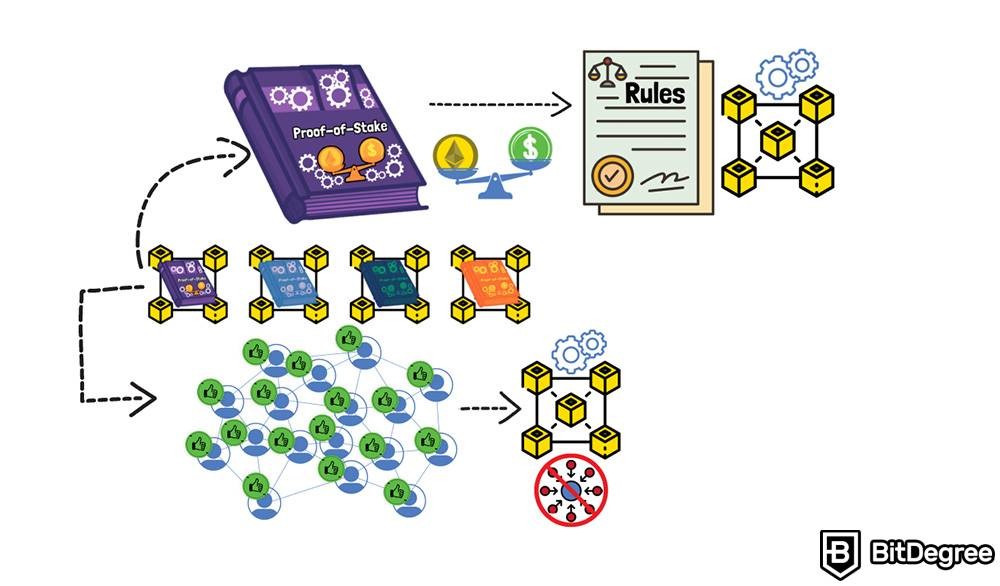
Let’s consider checkers. It’s a classical game with its own rules. Those who want to play checkers, they will follow the rules. An agreement to follow these rules is a consensus reached by the players.
So, in order to actively interact with a blockchain network, participants make a choice whether their idea of how a blockchain should work aligns with the principles of the consensus mechanism. If they agree, they accept the rules. In other words, they reach a consensus.
So, you can view consensus mechanisms as an agreement on how a blockchain should operate. Among the most prominent consensus mechanisms are Proof-of-Work and, the already mentioned, Proof-of-Stake, or simply, PoS.
As I've said before, staking is an inseparable part of blockchains that run on Proof-of-Stake. So, what makes it so different?
At its core, Proof-of-Stake is a consensus process that enables a network of validators to stake native tokens of a certain blockchain so they could become able to validate and create new blocks. Validators get block rewards for their work.
In Proof-of-Work, for example, the right to validate and create new blocks is reserved to crypto miners. They invest in their crypto mining rigs to max out the output of computational power that they can create. By doing so, they increase their chances of winning the “race” of getting the right to validate blockchain data. You could say that the main principle of PoW is competition.
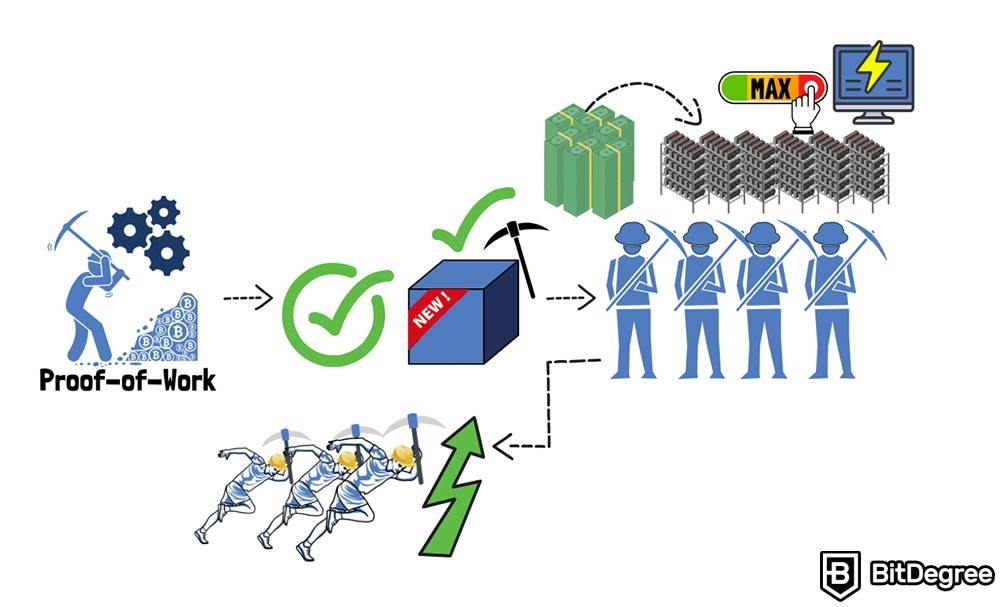
By the way, if you want to learn more about crypto mining, be sure to check out this section. Understanding mining will make it easier to understand the role of staking!
In PoS, on the contrary, people, who choose to stake their assets, become eligible to get randomly assigned the right to validate and create blocks. Of course, the higher the stake, the higher the chances of being selected to validate new transactions, and thus, receive rewards. Therefore, one could say that in PoS, the main principle is not competition, but a lottery.
It’s important to note that PoS is generally viewed as substantially more energy-efficient than PoW, since it doesn’t require all of the network’s validators to compete, and thus, use colossal amounts of electricity.
By the way, when it comes to PoS, there’s also something known as DPoS, or Delegated-Proof-of-Stake. It’s a popular modification of the standard PoS consensus mechanism. In DPoS, you can delegate your coins to other validators who manage high-performance computers, which are known as nodes, and ensure they run smoothly. This means you don't need to set up your own node to participate in staking.
Ways of Staking Crypto
Having explained all that, it’s safe to say that staking plays a major role in the DeFi world.
PoS blockchains simply need stakers, not only to survive, but to run properly. So, it’s only natural that staking comes in many shapes and sizes, among which the most important are traditional staking (by setting up a node), and a more beginner-friendly way of doing it, centralized exchange-based staking.
Up to this point, I’ve described the function of staking, and that it takes to lock away one’s asset in order to become a validator. But, sometimes, it can get tricky.
For example, in order to become an independent validator on the Ethereum network, a network participant has to lock away 32 ETH. And that’s not some pocket money. Not everyone has that much!

Therefore, such concepts as “collective nodes” have been developed. It is just what it sounds like. A node, run by a collective of people, who share the rewards amongst themselves. The main principles here are similar to the ones of collective mining. Be sure to check out this section to learn more!
Staking is accessible to both industry pros, and rookies. Because you can participate in staking by going the full way - setting up a node and becoming a full validator, or, going the easier way, by simply opting in for staking services provided by wallets, exchanges, and so on.
By the way, what, actually, is a “node”?
A node is a computer set up for the purpose of supporting the blockchain. Now, having a node all set up, network participants can choose to stake their crypto assets. After having staked the required amount, they become full, independent validators.
But setting up your own node is a lot of work, and certainly not everyone possesses the necessary knowledge to set up a node on their own. Therefore easier, more user-friendly ways of staking have been introduced.

Centralized crypto exchanges realized that simple access to staking would be a sought-after service. So, they created something that’s now known as “CEX-based staking.” It involves staking cryptocurrency on a centralized exchange platform.
These CEXs act as intermediaries between the PoS blockchains and less tech-savvy network participants. This service facilitates the process of becoming a staker, allowing those who are interested in earning rewards by staking their cryptocurrencies directly on a platform provided by the CEX.
Risks of Staking Crypto
As you can see, staking does play a major role in crypto. Yet, as always, there are two sides to a coin, and there’s a reason why questions like “is staking crypto safe?” are being asked. But the risk of staking crypto comes in more subtle ways.
The most important risk comes from crypto being volatile. To stake crypto means to lock it away. Taking into consideration how quickly the value of certain cryptos changes, there’s no guarantee that once you take back your staked assets, they’re gonna be as valuable as they were the day you chose to stake them.
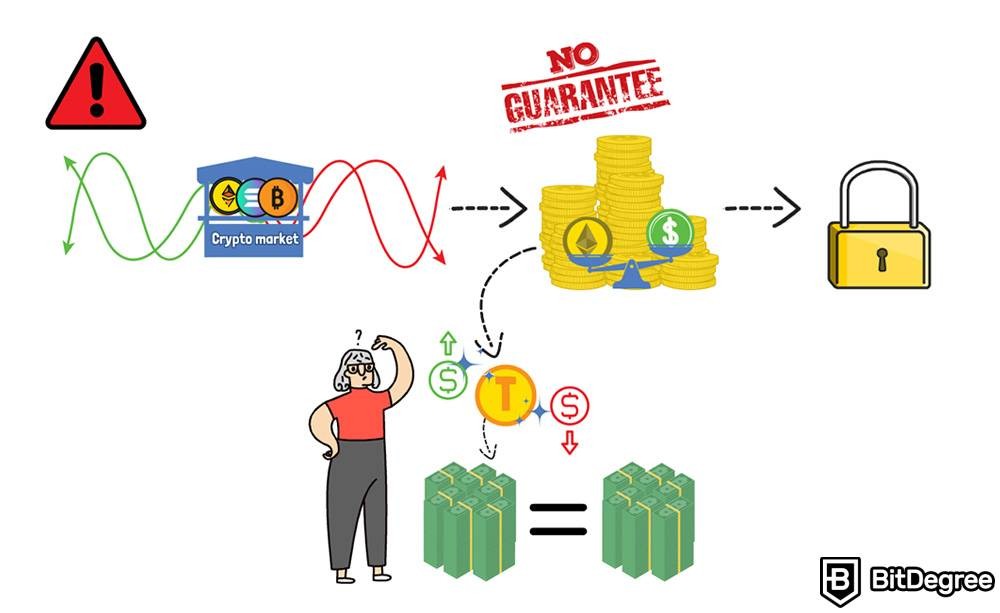
One more risk of staking crypto is seen from the security angle. In some cases, staking your coins means locking them on an external platform. In case of a security breach, your staked coins could be exposed to malicious actors. Therefore it’s important to choose a trustworthy platform before staking your coins, or, simply, go for staking options which would not require you to stake the assets on an external platform.
One more risk comes from the relationship between the crypto industry and regulatory affairs. As already mentioned, staking takes time, since it involves locking away one’s crypto. During that period of time, unexpected changes in laws and regulations may be passed, which could be detrimental to certain tokens, blockchains, or staking, as such.
So, no matter how good of a crypto staking calculator you’d use before making a decision, the question of “is staking crypto worth it?” cannot be answered in a few words. The rewards are real, and there’s a reason why staking is so popular. Yet, the risks are also always there.
Wrapping Up
By now, I’ve explained what is staking crypto, what is PoS, addressed the question “is staking crypto safe”, as well as the risks that are associated with it. Thus, this brings us to the end of this section. I hope that you found value in it, and that crypto staking will no longer cause confusion to you. To learn more about the DeFi world as a whole, check out other sections in this Crypto 101 Handbook.










